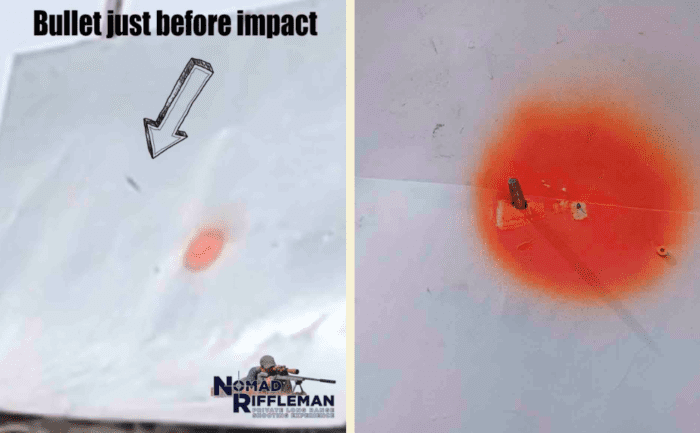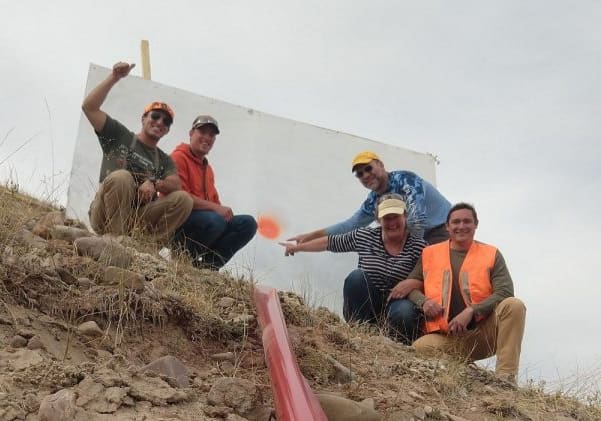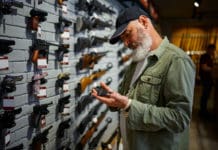
Twenty-four seconds from trigger pull to impact. A downward trajectory of 48 degrees. Hand-lathed custom bullets. Impacts that spotters couldn’t see so had to listen for. That’s what the shooters of the Nomad Rifleman team were dealing with who set a new ELR record with a 4.4 mile rifle shot.
The shooters involved in the effort — which has been in the planning since 2020 — were shooting a custom-built rifle chambered in .416 Barrett. They used forward observers in protected positions who helped them locate misses and walk their shots in on the target. Even then, it took 69 shots before a 422 grain round hit almost dead center.
From Nomad’s press release . . .
When testing finally began, each test required the team members to coordinate their schedules away from work, and with at least one forward spotter and Scott shooting, this was a challenge. “We learned that with our 422 grain bullet landing at 689 feet per second, there was rarely enough dust signature to see where the impact point was. In this kind of shooting, a spotter sees an impact and then tells the coach, who does the data crunching, and advises the shooter how to adjust before taking the next shot. But the bullet “splash” wasn’t visible at this range. The forward spotter, typically either Shepard or his wife, Lynn Sherwood-Humphries, when more than 100 yards from the target, would most frequently hear a whistle above, right or left, and a “thump” somewhere behind or between them and the target, but could not see any dust. They needed to get closer to the target to hone in on the point of impact, which is tricky.
The three of them considered a number of solutions, and Shepard settled on what he thinks might be(?) a brand new concept in ELR, audio spotting. Audible spotting has already been used to supplement visual spotting, but there are no other known examples of someone trying to spot with ears as the primary tool. In this new system, spotters get as close as safely possible to the target and listen for thumps and triangulate the sounds.
Here are the specs on the rifle and other gear used . . .
- The rifle, with customized parts and accessories from Canada, New Zealand, Arkansas, South Dakota and elsewhere, was assembled in Idaho by S&S Sporting in Driggs, Idaho.
- Rifle is chambered in .416 Barrett
- Chassis is a Cadex Dual Strike from Canada
- Barrel is an LRI from Sturgis, SD – 40” with a 1:9 twist. These folks are amazing in every way.
- The barrel was “structured” by tacomHQ in Arkansas.
- Action is a McMillian TAC50.
- Trigger is a Timney.
- Muzzle brake is a Terminator T6 from New Zealand.
- The 350 MOA mount was custom built by S&S Sporting in Idaho.
- The custom high-rise cheek piece was built by S&S Sporting.
- The scope is the recently-released Vortex Razor 6-35×56 FFP scope with EBR-7D MOA reticle. This scope is the latest and greatest from Vortex Optics. After testing many other top-tier brands, Scott decided that this Razor was our best option.
- The scope was held in place with a double set of Leupold Mark IV rings.
- Support optics included a Delta and a Charlie TARAC from tacomHQ.
- The bipod was a LRA.
- Scott designed and built the shooting platform.
- Ballistic software used – Applied Ballistics.
Here’s video of the record-breaking shot . . .
As Cowboy State Daily reports . . .
Landing a bullet on target at 4.4 miles was “simply phenomenal,” said long-distance shooting enthusiast David Asmuth of Laramie. He’s the president of the Laramie Rifle Range board of directors.
“It’s a one-in-a-million shot. They said it’s not statistically repeatable,” he said. “The amount of precision and time that went into that shot was simply amazing.
“When a bullet is in flight for that long, you have to take into account the rotational speed of the earth. What you’re shooting at isn’t going to be in the same place it was 24 second ago when you pulled the trigger.”
Ashmuth said the longest shots he’s ever made were 2,220 yards with a bullet flight time of about 4-5 seconds.
A massive flight arc had to be calculated to make the 4.4 mile shot work, Humphries said.
The angle of the rifle’s barrel, coupled with shooting from a ridge above the target, accounted for the arc in the bullet’s trajectory, he said.
“That made it more like artillery, where you’re lobbing it in,” Humphries said.

And extremely difficult to repeat.
Shepard [Humphries] and Scott [Austin] are quick to point out that their hit is not scientifically consistently “repeatable” even with the same several hours spent walking the shot in to the target. The temperature outside and within the barrel, the speed and direction of the wind at various distances between the shooter and the target, especially at max ordinate above 2,500 feet, will not ever be the same again. Those factors, as well as other environmental conditions, make a shot like this very challenging each time it’s attempted.
“We could obviously put a few more shots in the bullseye right in a row right now, but we are tired, so we will stop shooting and strut away now,” Shepard joked. “‘Luck’ isn’t the right word; perhaps ‘probability’ is a better word. Had Winston shot another 50 shots, none might have hit the target, or at best, perhaps a few would have, and they probably wouldn’t have been in the bullseye.” In a strange coincidence, it was their 69th shot that hit the target, breaking Paul Phillips’ 4-mile record shot which also landed on the 69th shot.
Read Nomad Rifleman’s full press release here.
[h/t Instapundit]




When will they try the 4,5 mile shot on an elk?
At an approach velocity of only 689 fps, it’d only piss off the elk.
“More like artillery” indeed. Impressive. And Cadex 🇨🇦 👍 makes some damn nice stuff. The elk would never know what hit it but I’m sure it would be checking around.
Maybe not if it hit in the right place . Most 9mm LUGER had around that MV. But you cannot buck the laws of Physics everything falls at 32 ft per sec per sec. That why the shot had to be taken from the top of a mountain. In the WW1 the British Infantry were trained to use the LEE-ENFIELD .303 to shoot OVER hills into troop concentrations. In fact as a sort of improvised Artillery.
Missing from the specs is what IMHO would be the most interesting part, the price of the various components.
I think this files under those “if you have to ask” situations.
That might actually be something less than straightforward to calculate. How many different components did they try and discard? Do you include that in the final cost? And components came from a lot of different suppliers in different locations. How much did they end up spending on shipping and insurance? Does THAT get included?
All that aside, I agree with you. It would have been interesting to see all those numbers.
Given enough time enough monkeys with enough typewriters could come up with War and Peace also. I would be impressed if he did it on the second or third shot. Not so much on the 69th
MB,
I think the greatest challenge on that shot was:
a) Keeping the scope crosshairs on the target at time of shot.
b) Landing a shot on target with unknown wind conditions.
And I think that second consideration–not knowing the wind conditions on the entire length of the bullet trajectory–is the biggest challenge of all.
In terms of the bullet trajectory and Earth’s rotational Coriolis effect, those are relatively simple Mathematical calculations.
As for keeping the scope crosshairs on target when squeezing the trigger, that might even be fairly easy depending on how the shooter supported and held the rifle.
The wind could be swirling in an infinite combination of directions and speeds along the path–and changing from moment to moment. That is the variable that is impossible to overcome and makes consistent repeatability impossible in my opinion.
@MB,
My exact takeaway from the article. Very cool that they landed the shot on such a small target at 4.4 miles, but with even the entire team conceding it was a “one in a million shot” that “likely couldn’t be repeated” because they kept lobbing bullets in that direction and only stopped because the 69th(!!) finally hit…I wouldn’t really call that an achievement.
Something to take a group selfie and keep as a campfire story? Absolutely. But give me unlimited ammo and attempts, and I might find that bullseye at some point, too.
If a shooter can land a bullseye at 1000 yds within five attempts, then repeat it within the next five attempts, that’s skill.
If you believe that, you should make time to attend the National Matches some year. Winning long range (1000 yards) scores are invariably determined by number of “X”es, since there are several perfect scores otherwise, 10 out of 10 bullseyes.
So…proving my point, then?
more like a stunt…nothing practical here…
Yes, but depending on who you ask, that amount of time could be longer then the lifespan of the universe.
Almost every year in some Middle East country, people celebrating at a party or wedding by firing their AKs in the air manage to kill some random person at some indeterminate distance downrange. Does that make it a “sniper shot” now?
This is cool and all, but sort of akin to stunt shooting. Actually, stunt shooting requires actual marksmanship skill. With this shot it’s the spotters and resident ballistician doing all the work (which isn’t really out of the ordinary for long shots anyway). The guy pulling the trigger on a stoutly supported rifle isn’t really doing that much special.
Yeah it seems kind of pointless. The guy who made the 2 mile (or however long) shot in Iraq(?) combat conditions is still *far* more impressive. IIRC he took 7 sighting shots to do it but then made actual hits 3 times in a row.
Not to criticize somebody’s hobby – seriously, have fun with it – but this should probably have stayed in the territory of a bar story among friends rather than a press release.
I agree! How about a repeatable standard for longest shot on target. Something like 50 rounds ands and 5 must impact the target. Only one attempt per day allowed, that is no more than 50 rounds allowed that day, and only one person can attempt per day. Any other ideas?
24 Seconds to Awesome.
actually the evidence seems to indicate it is a one in sixty nine shot … not a one in a million shot. )
was thinking the same thing
Cool!😎
In some regards this is not impressive at all. If I keep shooting at something and have spotters telling me where my misses are landing, I would eventually hit the target.
Having said that, being able to hit a target at 4.4 miles is pretty spectacular even with all of their effort and taking 69 shots to do it.
At what range could this rig and team make a hit with the first shot from a cold bore? I bet its significantly less than what they achieved. I guess these efforts will trickle down to regular rigs in the future.
The difference in difficulty between 800 yards and 1000 yards, I can personally attest, is quite dramatic, difficult to believe. I can only imagine 2000 yards, and 4000 boggles the mind. If you haven’t tried it, take my word for it. I was firing an M1A National Match with stock iron sights and milspec ammo. And the largest difference, at least for a novice like me, was reading the wind and making corrections to the sights. But yes, I could hit the target every time, mostly in the 9-10 rings.
Between 800 and 1000m, .308 starts to go transonic and this causes increased dispersion. Some fullbore shooters told me they increase the load to keep it supersonic out to 1000m.
I only shoot to 400m in service match so I can use milder loads.
Now that they’ve taken their 69 shots to “dial it in “, are they able to set up the following day and repeat the shot? I suspect that over a distance this long, wind, temperature, even time of day and angle of sunlight, will introduce enough variability to necessitate another long series of shots to repeat. In other words, this is a meaningless exercise. It’s the equivalent of 69 monkeys with rifles. The only purpose it serves is to reinforce the fourth safety rule of knowing what’s behind your target.
Story time: Way back at the turn of the Millennium when young BASHer was in Florida the Space Shuttle was still in active service. It descended at supersonic speeds and if you happened to be in a parking lot when it came down you could determine its relative location by sequence in which the car alarms went off.
“That’s a custom Barrett, you’ve had your six(ty-nine.)”
Sorry Mr.s Fleming and Bond.
Ragging on a 4.4mile shot. DUH…
Bond died in the last movie. Which ticked me off to no end.
Bond had to die, because all white men need to die. If he wasn’t killed off, they wouldn’t have been able to make the next Bond some homeless, androgynous non-binary pseudo-female minority liberal with a drug addiction who hates guns and loves communism.
Oh, and who’s had several abortions as well.
This 4.4-mile shot accomplishes nothing. All it proved was that this rifle round could travel 4.4 miles.
Looks like fun!
If I had lots of disposable $$ it would be a hoot to build something like this rifle and shoot it at extreme long ranges. Should be a tack driver at a mere two miles.
Could be just the thing for antelope hunts on the east side of the State…them critters are hard to stalk… 🙂
All you nay sayers (FUDD’s for the most part) should support these guys (and gals) efforts as part of the POTG brother / sister hood.
Montana, absolutely. And they’d all be dancing around like at a hoe-down if they managed it.
You guys are a lot harder to impress than I am. I thought this was pretty cool! I still have zero interest in shooting anything beyond 300 yards though, but I think it’s super fun when other people do.
Pushing the limits is how we get better and better things.
So they made a .416 Barrett into essentially a modern .45-70 😇
Yup. Except the 45-70 would’ve still knocked the target over 😉.
If you get a decent telescope you can see the dent I put in the plaque on the Moon with an 03A3 and Remington 220gr rnd nose soft points.
That’s nothing. I created the rings of Saturn with a 6.5 creed moor and singly-handedly ended the the Iranian nuclear program with my .9 mm Glock 🤣
@kahill
I think your blowing out uranus.
Nah, that’s just the chili I had last night 😇😉
The deadliest mushroom in the solar system.
I have a couple rifles capable of reliable 1-mile shots. And several that can bang out the 1000-meter 5in. steel plate all day. And that is with my myopic eyes. 4+ miles by launching Howitzer style shots for bragging rights is fine if that is the goal. for me, if there isn’t a practicle purpose, what’s the point?
If God would have wanted humans to fly He would have made them look like Bats.
Because Everest is to big to not climb.
Besides its Wyoming, not much else to do there.
With spotters and 69 rounds to finally hit target, smells more like pointless dick waving than anything of use.
Dissecting your reply makes it really quite humourous.
Did you do that on purpose and if so job well done.
👍
I’m a curious person, both meanings, I’d like to know the max apogee of the bullets. They might should of contacted the FAA for airspace clearance Clarence.
And/or the Space Force for L.E.O. Clearance.
Well, good on them.
At the same time, meh. It is up there with land speed records, or fastest lap at Daytona.
The average shooter could not accomplish it, but maybe the average shooter can rank High Master at NRA High Power. I think that would be more impressive.
I’d like to see how many people who are poo pooing the feat could accomplish it in twice the shot. Not my cup of tea, but I realize the skill it takes to do what he did and its not something I could do.
Absolutely incredible,
sure it took 69 shots… nice.
but as someone who pokes holes and rings bells for fun. I know it is quite a shot.
the furthest distance I have ever shot was 2200 meters with my .338 Lapua Ackley Improved. going for and that was not cake. also went for a 1 mile shot, was trying for a milk jug, (look up long range shooters of utah)
couldn’t get it on my first try, hope to try again soon.
Comments are closed.